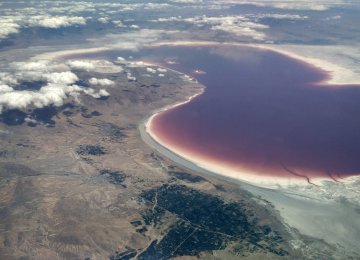Efforts to revive Urmia Lake in northwest Iran were progressing well until this year when the lake's level again started to decline and the officials of Urmia Lake's Restoration Program drew widespread criticism for failing to meet the targets.
Certain groups have argued that the assignment of the program's top officials to positions in the Department of Environment has been the cause of ULRP's poor performance in recent months.
Isa Kalantari and Masoud Tajrishi, the ULRP administrator and director of the program's Planning Office, were appointed as the head and deputy of the Department of Environment respectively earlier in the summer.
Speaking to Tabnak news website, Tajrishi dismissed the criticism and claimed that their full-time service is not a matter of concern now that the lake's water level has been stabilized.
"I was holding a full-time position as the research deputy of Sharif University of Technology in the previous round too, so the claim that my simultaneous posting at DOE has left me no time for Urmia's restoration plans is baseless," he said.
Besides, the program's progress at this stage relies on executive organizations such as the ministries of agriculture and energy that are in charge of carrying out related projects, the universities of Tabriz and Urmia for monitoring and the Ministry of Economy and Planning and Management Organization for allocation of funds.
Current plans for the lake include fostering a culture of economization, promoting modern agricultural techniques, introducing new technologies to the region and addressing issues concerning plant seeds and farming methods.
Tajrishi added that the new appointments have made the conditions even better.
"Dr. Kalantari is now a member of the Cabinet and we can present our demands to executive authorities more easily and firmly," he said. Another benefit of the present situation, according to the official, is that the model of ULRP can be used in other environmental programs.
"In my own plans at DOE, I intend to use the model for issues such as air pollution or restoration of other wetlands," he said.
He stressed that although the program is not going on well at the restoration phase, its overall progress has been positive.
"Our job is to plan, study and supervise, and we are carrying it out as before and even better," he said, adding that the causes of the regression has to be sought elsewhere.
According to Tajrishi, ULRP was to receive 2 trillion rials ($50 million) annually based on the initial plan. Last year, only 800 billion rials ($20 million) were approved, but the program only received 300 billion rials ($7.5 million).
"This year, only 200 billion rials ($5 million) were allocated and paid belatedly in the cold season when conservation programs are less effective. This sum is actually last year's debt and in fact, ULRP has received no budget from the government this year," he said.
The daily level of Urmia stood at 1,270.22 centimeters in November with a 26-cm decline compared with the same period of last year.






Add new comment
Read our comment policy before posting your viewpoints